Motivational Theories and Approaches for Woolworths, Australia Report
VerifiedAdded on 2020/05/28
|22
|4928
|368
Report
AI Summary
This report provides an in-depth analysis of various motivation theories and their application within the context of Woolworths, an Australian company. It begins with an executive summary and table of contents, followed by an introduction that outlines the report's objectives, which include differentiating between process and content theories, and analyzing the application of Maslow's, Herzberg's, and McGregor's theories within Woolworths. The report provides an overview of Woolworths, highlighting its market position and key financial metrics. It then delves into the core theories, contrasting process and content theories and examining Maslow's Hierarchy of Needs, including its criticisms, and Herzberg's Two-Factor Theory, also addressing its criticisms. The report explores the assumptions of Theory X and Theory Y, and it relates Hofstede’s six-dimension approach to the motivational theories. The conclusion synthesizes the findings, emphasizing the importance of understanding diverse motivational approaches for enhancing employee productivity and organizational success within Woolworths. The report utilizes relevant figures and references to support its analysis.
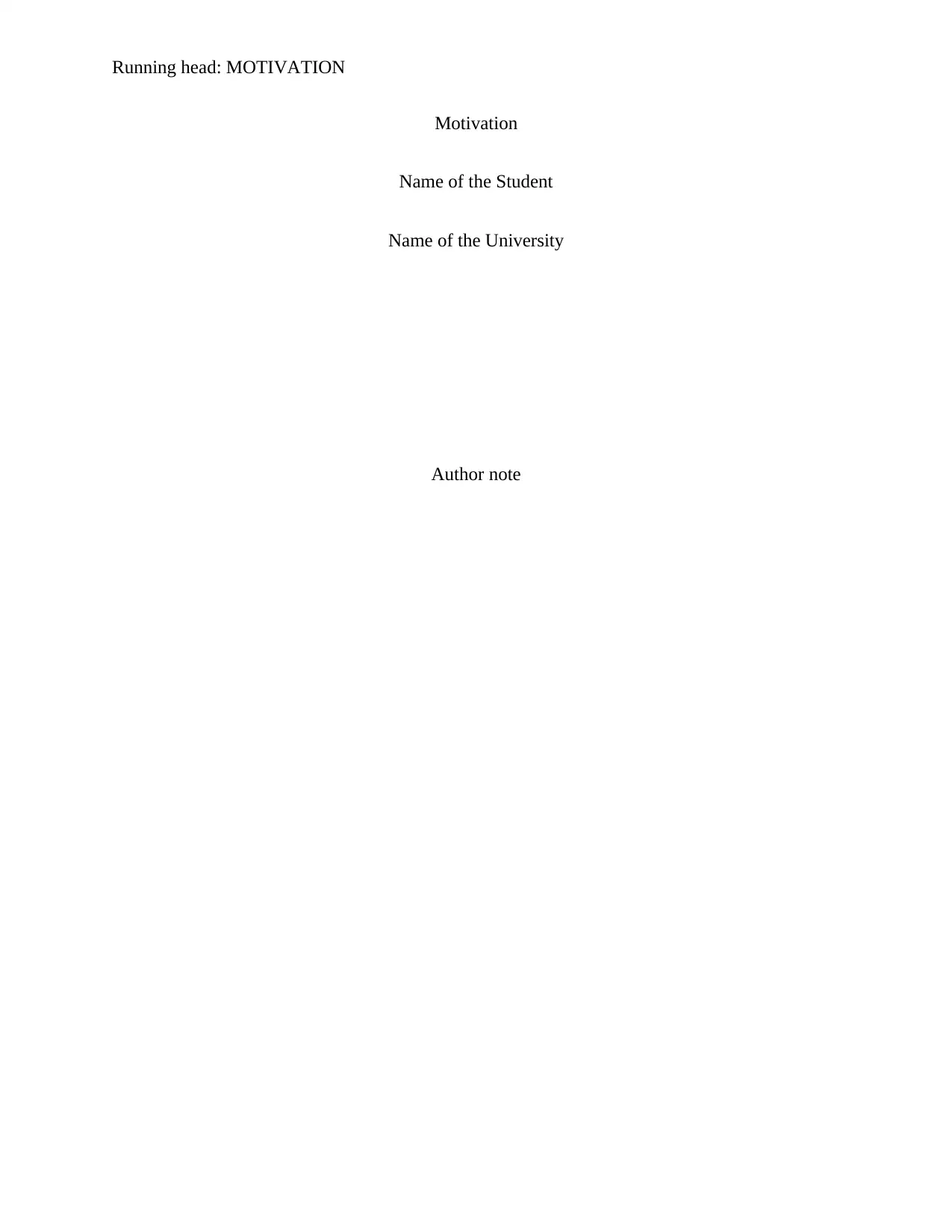
Running head: MOTIVATION
Motivation
Name of the Student
Name of the University
Author note
Motivation
Name of the Student
Name of the University
Author note
Paraphrase This Document
Need a fresh take? Get an instant paraphrase of this document with our AI Paraphraser
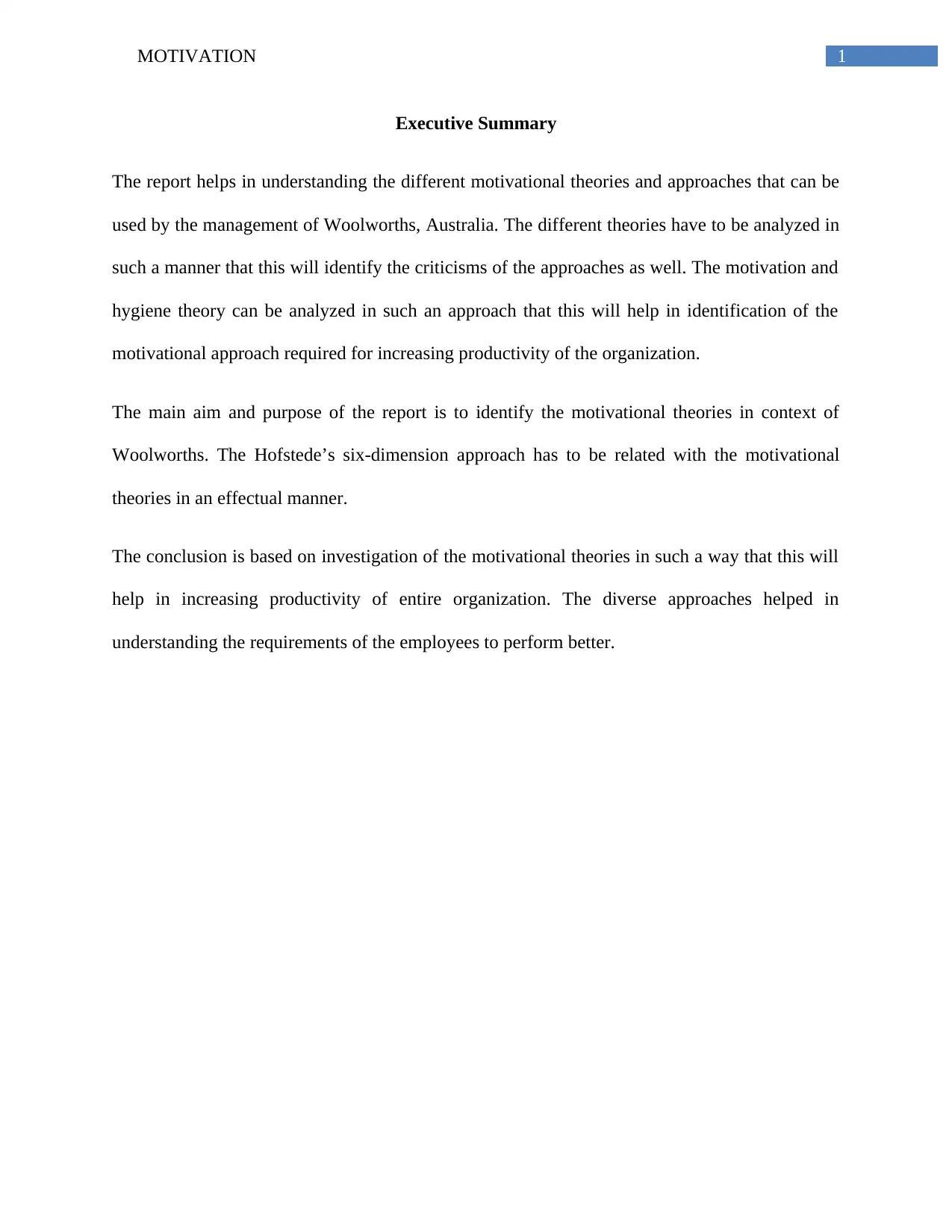
1MOTIVATION
Executive Summary
The report helps in understanding the different motivational theories and approaches that can be
used by the management of Woolworths, Australia. The different theories have to be analyzed in
such a manner that this will identify the criticisms of the approaches as well. The motivation and
hygiene theory can be analyzed in such an approach that this will help in identification of the
motivational approach required for increasing productivity of the organization.
The main aim and purpose of the report is to identify the motivational theories in context of
Woolworths. The Hofstede’s six-dimension approach has to be related with the motivational
theories in an effectual manner.
The conclusion is based on investigation of the motivational theories in such a way that this will
help in increasing productivity of entire organization. The diverse approaches helped in
understanding the requirements of the employees to perform better.
Executive Summary
The report helps in understanding the different motivational theories and approaches that can be
used by the management of Woolworths, Australia. The different theories have to be analyzed in
such a manner that this will identify the criticisms of the approaches as well. The motivation and
hygiene theory can be analyzed in such an approach that this will help in identification of the
motivational approach required for increasing productivity of the organization.
The main aim and purpose of the report is to identify the motivational theories in context of
Woolworths. The Hofstede’s six-dimension approach has to be related with the motivational
theories in an effectual manner.
The conclusion is based on investigation of the motivational theories in such a way that this will
help in increasing productivity of entire organization. The diverse approaches helped in
understanding the requirements of the employees to perform better.
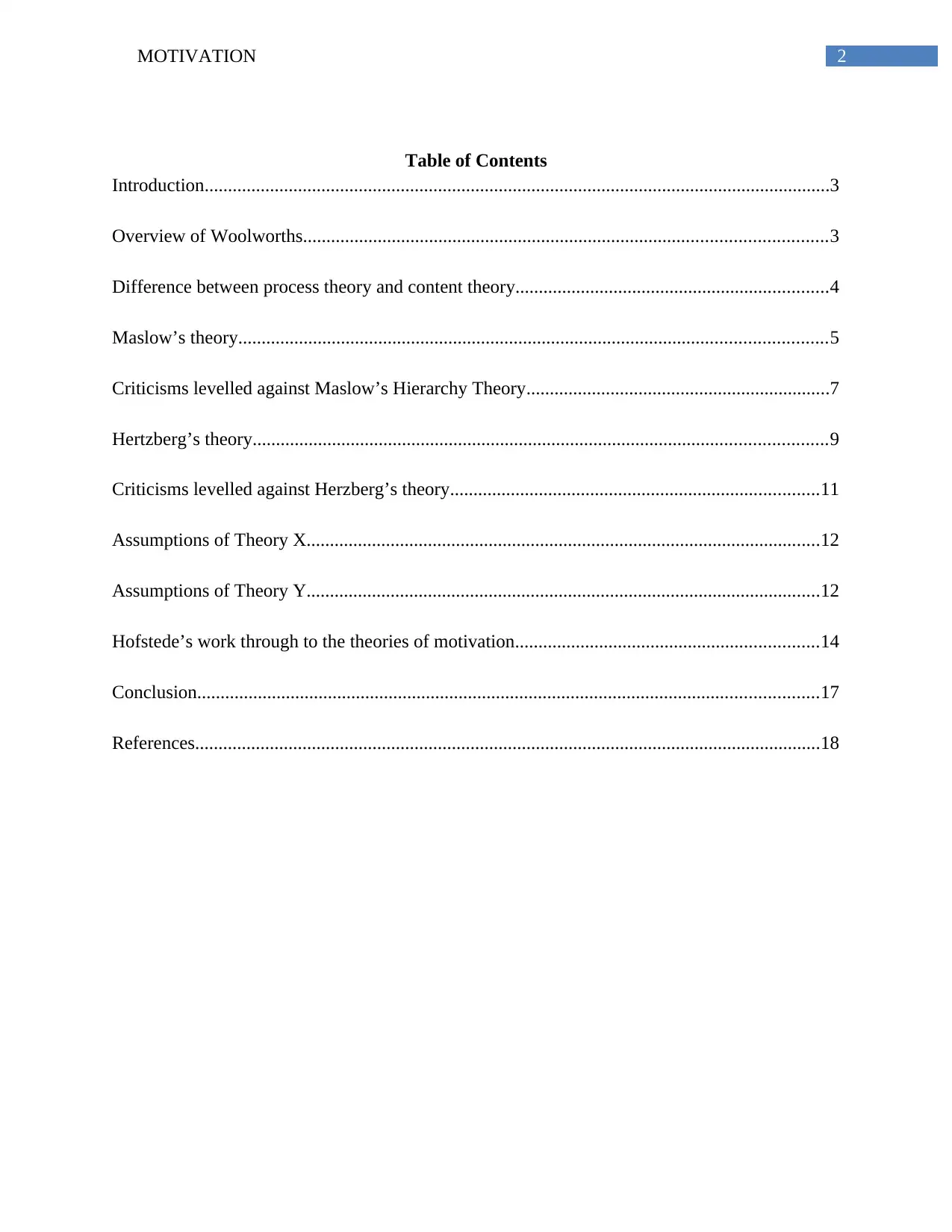
2MOTIVATION
Table of Contents
Introduction......................................................................................................................................3
Overview of Woolworths................................................................................................................3
Difference between process theory and content theory...................................................................4
Maslow’s theory..............................................................................................................................5
Criticisms levelled against Maslow’s Hierarchy Theory.................................................................7
Hertzberg’s theory...........................................................................................................................9
Criticisms levelled against Herzberg’s theory...............................................................................11
Assumptions of Theory X..............................................................................................................12
Assumptions of Theory Y..............................................................................................................12
Hofstede’s work through to the theories of motivation.................................................................14
Conclusion.....................................................................................................................................17
References......................................................................................................................................18
Table of Contents
Introduction......................................................................................................................................3
Overview of Woolworths................................................................................................................3
Difference between process theory and content theory...................................................................4
Maslow’s theory..............................................................................................................................5
Criticisms levelled against Maslow’s Hierarchy Theory.................................................................7
Hertzberg’s theory...........................................................................................................................9
Criticisms levelled against Herzberg’s theory...............................................................................11
Assumptions of Theory X..............................................................................................................12
Assumptions of Theory Y..............................................................................................................12
Hofstede’s work through to the theories of motivation.................................................................14
Conclusion.....................................................................................................................................17
References......................................................................................................................................18
⊘ This is a preview!⊘
Do you want full access?
Subscribe today to unlock all pages.

Trusted by 1+ million students worldwide
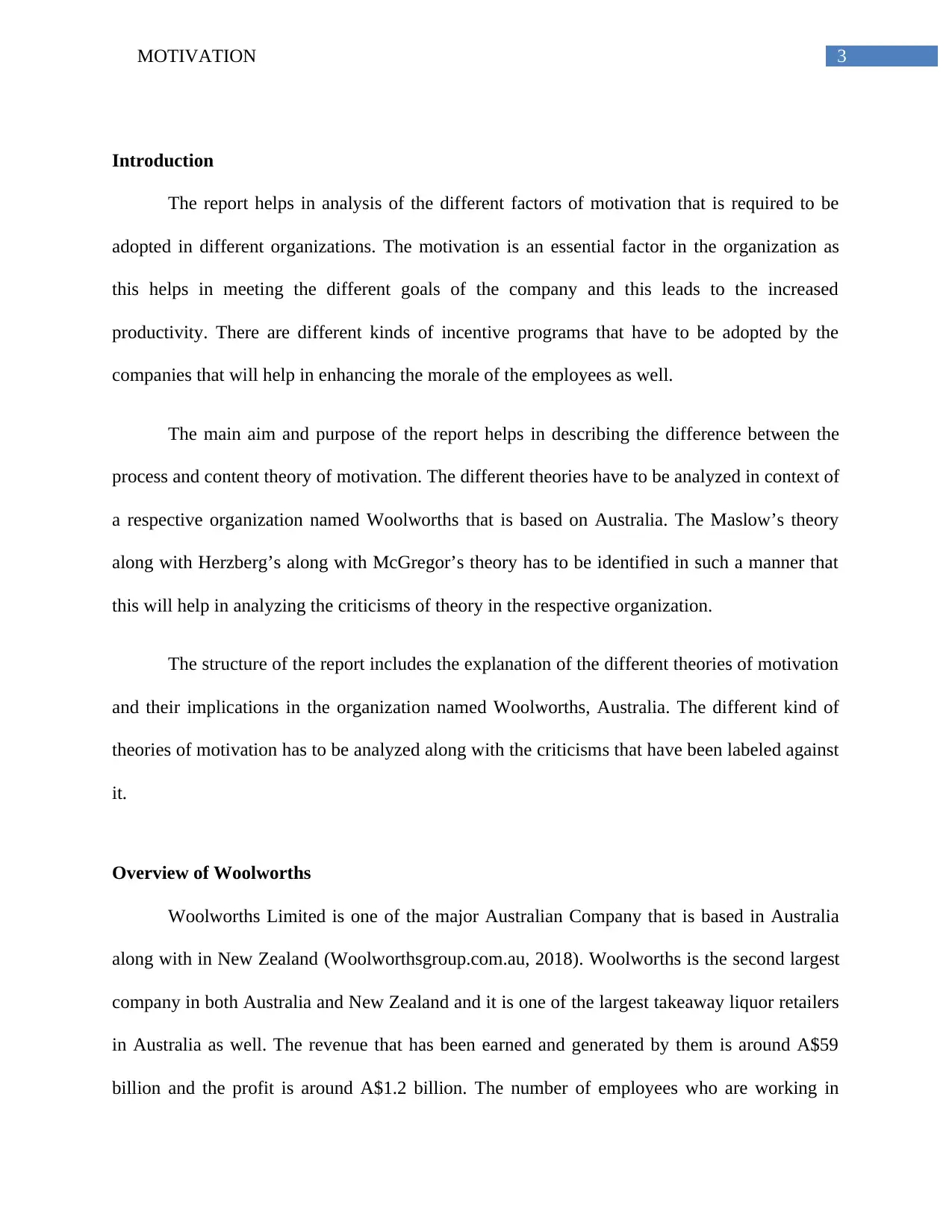
3MOTIVATION
Introduction
The report helps in analysis of the different factors of motivation that is required to be
adopted in different organizations. The motivation is an essential factor in the organization as
this helps in meeting the different goals of the company and this leads to the increased
productivity. There are different kinds of incentive programs that have to be adopted by the
companies that will help in enhancing the morale of the employees as well.
The main aim and purpose of the report helps in describing the difference between the
process and content theory of motivation. The different theories have to be analyzed in context of
a respective organization named Woolworths that is based on Australia. The Maslow’s theory
along with Herzberg’s along with McGregor’s theory has to be identified in such a manner that
this will help in analyzing the criticisms of theory in the respective organization.
The structure of the report includes the explanation of the different theories of motivation
and their implications in the organization named Woolworths, Australia. The different kind of
theories of motivation has to be analyzed along with the criticisms that have been labeled against
it.
Overview of Woolworths
Woolworths Limited is one of the major Australian Company that is based in Australia
along with in New Zealand (Woolworthsgroup.com.au, 2018). Woolworths is the second largest
company in both Australia and New Zealand and it is one of the largest takeaway liquor retailers
in Australia as well. The revenue that has been earned and generated by them is around A$59
billion and the profit is around A$1.2 billion. The number of employees who are working in
Introduction
The report helps in analysis of the different factors of motivation that is required to be
adopted in different organizations. The motivation is an essential factor in the organization as
this helps in meeting the different goals of the company and this leads to the increased
productivity. There are different kinds of incentive programs that have to be adopted by the
companies that will help in enhancing the morale of the employees as well.
The main aim and purpose of the report helps in describing the difference between the
process and content theory of motivation. The different theories have to be analyzed in context of
a respective organization named Woolworths that is based on Australia. The Maslow’s theory
along with Herzberg’s along with McGregor’s theory has to be identified in such a manner that
this will help in analyzing the criticisms of theory in the respective organization.
The structure of the report includes the explanation of the different theories of motivation
and their implications in the organization named Woolworths, Australia. The different kind of
theories of motivation has to be analyzed along with the criticisms that have been labeled against
it.
Overview of Woolworths
Woolworths Limited is one of the major Australian Company that is based in Australia
along with in New Zealand (Woolworthsgroup.com.au, 2018). Woolworths is the second largest
company in both Australia and New Zealand and it is one of the largest takeaway liquor retailers
in Australia as well. The revenue that has been earned and generated by them is around A$59
billion and the profit is around A$1.2 billion. The number of employees who are working in
Paraphrase This Document
Need a fresh take? Get an instant paraphrase of this document with our AI Paraphraser
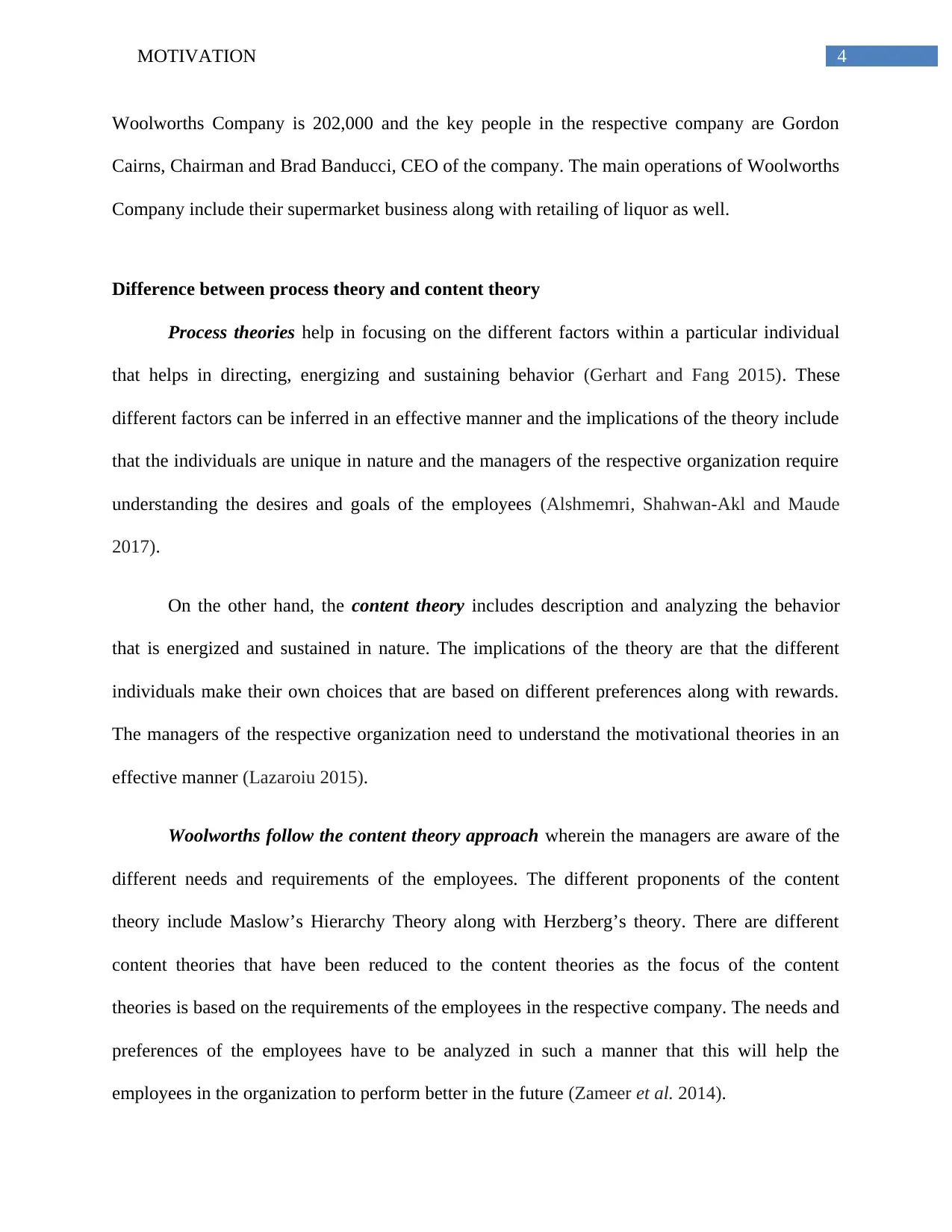
4MOTIVATION
Woolworths Company is 202,000 and the key people in the respective company are Gordon
Cairns, Chairman and Brad Banducci, CEO of the company. The main operations of Woolworths
Company include their supermarket business along with retailing of liquor as well.
Difference between process theory and content theory
Process theories help in focusing on the different factors within a particular individual
that helps in directing, energizing and sustaining behavior (Gerhart and Fang 2015). These
different factors can be inferred in an effective manner and the implications of the theory include
that the individuals are unique in nature and the managers of the respective organization require
understanding the desires and goals of the employees (Alshmemri, Shahwan-Akl and Maude
2017).
On the other hand, the content theory includes description and analyzing the behavior
that is energized and sustained in nature. The implications of the theory are that the different
individuals make their own choices that are based on different preferences along with rewards.
The managers of the respective organization need to understand the motivational theories in an
effective manner (Lazaroiu 2015).
Woolworths follow the content theory approach wherein the managers are aware of the
different needs and requirements of the employees. The different proponents of the content
theory include Maslow’s Hierarchy Theory along with Herzberg’s theory. There are different
content theories that have been reduced to the content theories as the focus of the content
theories is based on the requirements of the employees in the respective company. The needs and
preferences of the employees have to be analyzed in such a manner that this will help the
employees in the organization to perform better in the future (Zameer et al. 2014).
Woolworths Company is 202,000 and the key people in the respective company are Gordon
Cairns, Chairman and Brad Banducci, CEO of the company. The main operations of Woolworths
Company include their supermarket business along with retailing of liquor as well.
Difference between process theory and content theory
Process theories help in focusing on the different factors within a particular individual
that helps in directing, energizing and sustaining behavior (Gerhart and Fang 2015). These
different factors can be inferred in an effective manner and the implications of the theory include
that the individuals are unique in nature and the managers of the respective organization require
understanding the desires and goals of the employees (Alshmemri, Shahwan-Akl and Maude
2017).
On the other hand, the content theory includes description and analyzing the behavior
that is energized and sustained in nature. The implications of the theory are that the different
individuals make their own choices that are based on different preferences along with rewards.
The managers of the respective organization need to understand the motivational theories in an
effective manner (Lazaroiu 2015).
Woolworths follow the content theory approach wherein the managers are aware of the
different needs and requirements of the employees. The different proponents of the content
theory include Maslow’s Hierarchy Theory along with Herzberg’s theory. There are different
content theories that have been reduced to the content theories as the focus of the content
theories is based on the requirements of the employees in the respective company. The needs and
preferences of the employees have to be analyzed in such a manner that this will help the
employees in the organization to perform better in the future (Zameer et al. 2014).
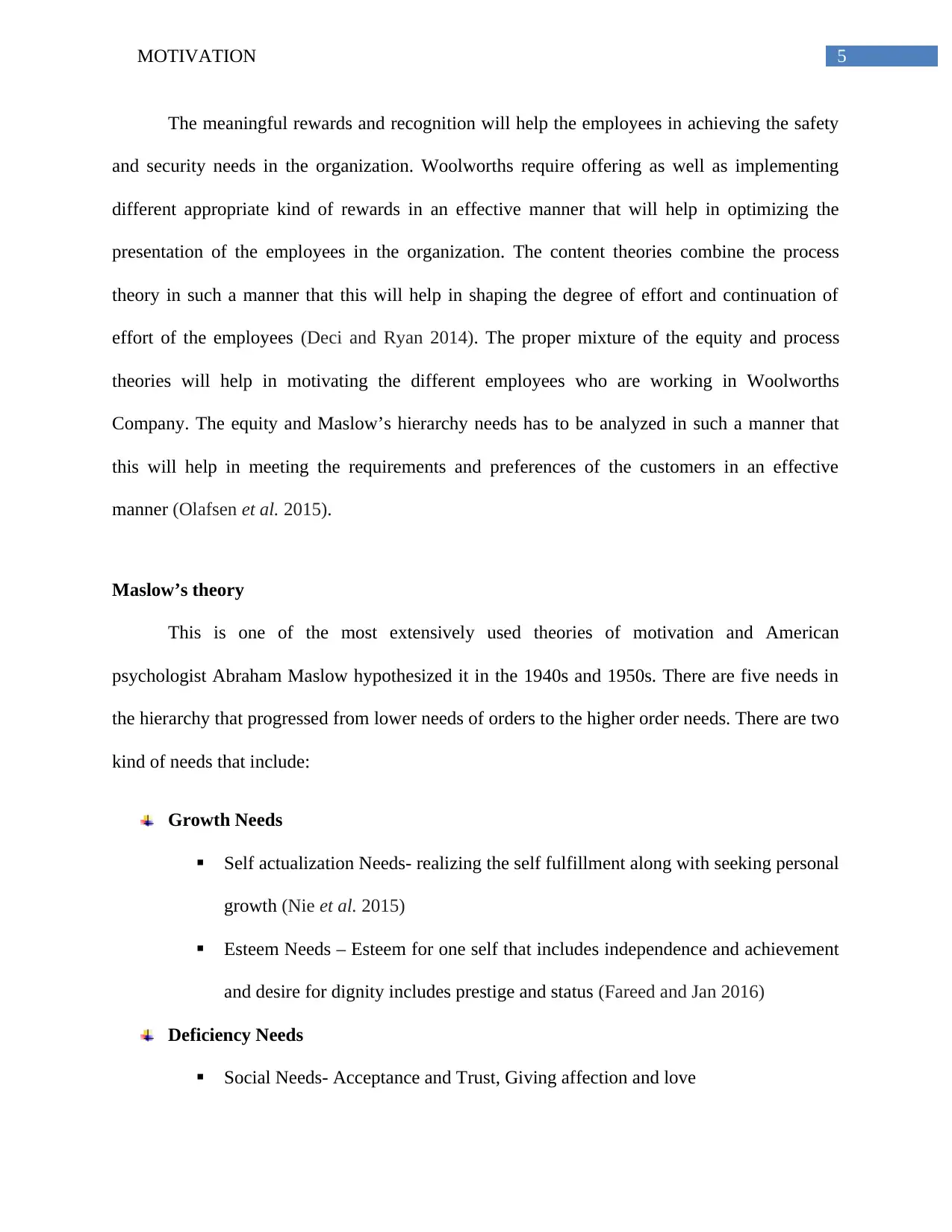
5MOTIVATION
The meaningful rewards and recognition will help the employees in achieving the safety
and security needs in the organization. Woolworths require offering as well as implementing
different appropriate kind of rewards in an effective manner that will help in optimizing the
presentation of the employees in the organization. The content theories combine the process
theory in such a manner that this will help in shaping the degree of effort and continuation of
effort of the employees (Deci and Ryan 2014). The proper mixture of the equity and process
theories will help in motivating the different employees who are working in Woolworths
Company. The equity and Maslow’s hierarchy needs has to be analyzed in such a manner that
this will help in meeting the requirements and preferences of the customers in an effective
manner (Olafsen et al. 2015).
Maslow’s theory
This is one of the most extensively used theories of motivation and American
psychologist Abraham Maslow hypothesized it in the 1940s and 1950s. There are five needs in
the hierarchy that progressed from lower needs of orders to the higher order needs. There are two
kind of needs that include:
Growth Needs
Self actualization Needs- realizing the self fulfillment along with seeking personal
growth (Nie et al. 2015)
Esteem Needs – Esteem for one self that includes independence and achievement
and desire for dignity includes prestige and status (Fareed and Jan 2016)
Deficiency Needs
Social Needs- Acceptance and Trust, Giving affection and love
The meaningful rewards and recognition will help the employees in achieving the safety
and security needs in the organization. Woolworths require offering as well as implementing
different appropriate kind of rewards in an effective manner that will help in optimizing the
presentation of the employees in the organization. The content theories combine the process
theory in such a manner that this will help in shaping the degree of effort and continuation of
effort of the employees (Deci and Ryan 2014). The proper mixture of the equity and process
theories will help in motivating the different employees who are working in Woolworths
Company. The equity and Maslow’s hierarchy needs has to be analyzed in such a manner that
this will help in meeting the requirements and preferences of the customers in an effective
manner (Olafsen et al. 2015).
Maslow’s theory
This is one of the most extensively used theories of motivation and American
psychologist Abraham Maslow hypothesized it in the 1940s and 1950s. There are five needs in
the hierarchy that progressed from lower needs of orders to the higher order needs. There are two
kind of needs that include:
Growth Needs
Self actualization Needs- realizing the self fulfillment along with seeking personal
growth (Nie et al. 2015)
Esteem Needs – Esteem for one self that includes independence and achievement
and desire for dignity includes prestige and status (Fareed and Jan 2016)
Deficiency Needs
Social Needs- Acceptance and Trust, Giving affection and love
⊘ This is a preview!⊘
Do you want full access?
Subscribe today to unlock all pages.

Trusted by 1+ million students worldwide
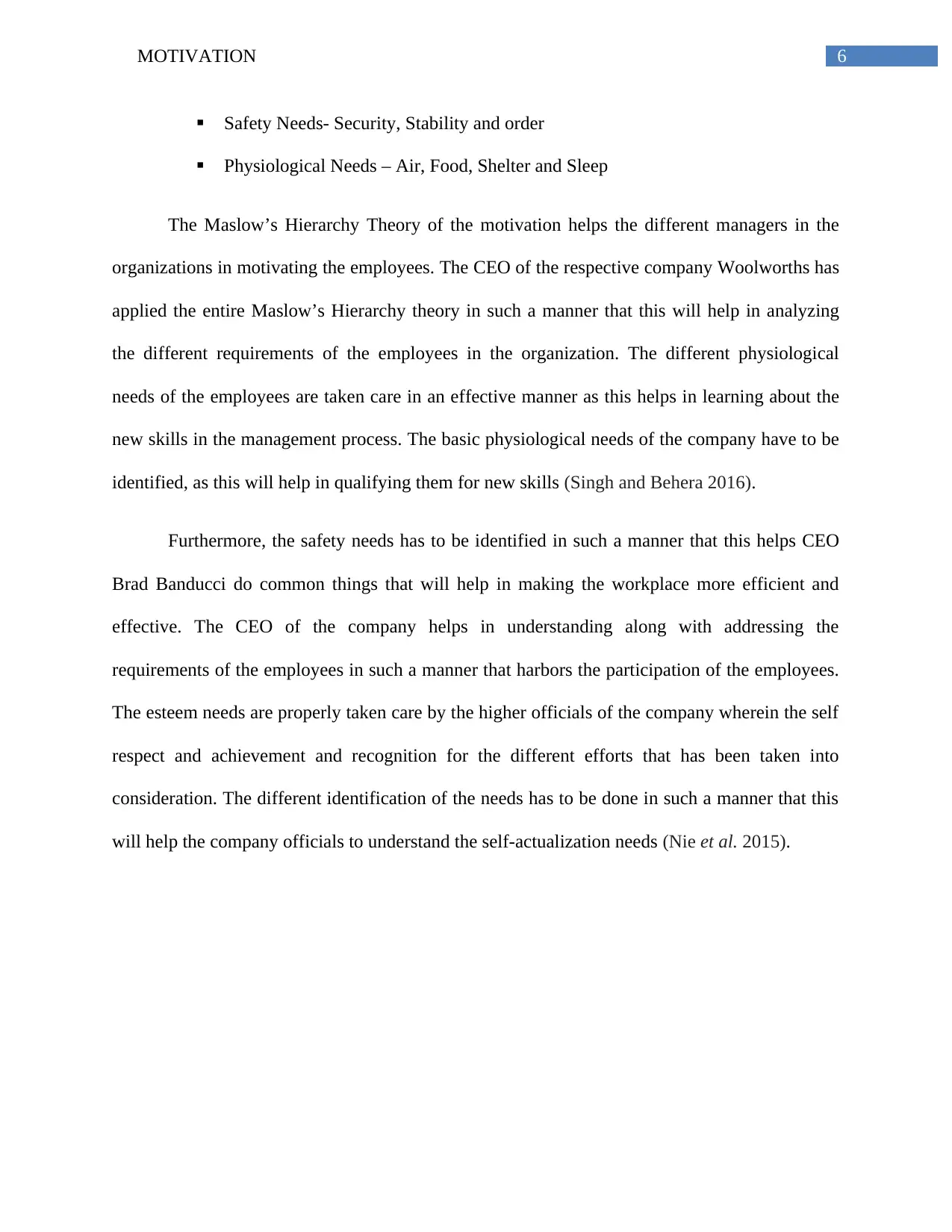
6MOTIVATION
Safety Needs- Security, Stability and order
Physiological Needs – Air, Food, Shelter and Sleep
The Maslow’s Hierarchy Theory of the motivation helps the different managers in the
organizations in motivating the employees. The CEO of the respective company Woolworths has
applied the entire Maslow’s Hierarchy theory in such a manner that this will help in analyzing
the different requirements of the employees in the organization. The different physiological
needs of the employees are taken care in an effective manner as this helps in learning about the
new skills in the management process. The basic physiological needs of the company have to be
identified, as this will help in qualifying them for new skills (Singh and Behera 2016).
Furthermore, the safety needs has to be identified in such a manner that this helps CEO
Brad Banducci do common things that will help in making the workplace more efficient and
effective. The CEO of the company helps in understanding along with addressing the
requirements of the employees in such a manner that harbors the participation of the employees.
The esteem needs are properly taken care by the higher officials of the company wherein the self
respect and achievement and recognition for the different efforts that has been taken into
consideration. The different identification of the needs has to be done in such a manner that this
will help the company officials to understand the self-actualization needs (Nie et al. 2015).
Safety Needs- Security, Stability and order
Physiological Needs – Air, Food, Shelter and Sleep
The Maslow’s Hierarchy Theory of the motivation helps the different managers in the
organizations in motivating the employees. The CEO of the respective company Woolworths has
applied the entire Maslow’s Hierarchy theory in such a manner that this will help in analyzing
the different requirements of the employees in the organization. The different physiological
needs of the employees are taken care in an effective manner as this helps in learning about the
new skills in the management process. The basic physiological needs of the company have to be
identified, as this will help in qualifying them for new skills (Singh and Behera 2016).
Furthermore, the safety needs has to be identified in such a manner that this helps CEO
Brad Banducci do common things that will help in making the workplace more efficient and
effective. The CEO of the company helps in understanding along with addressing the
requirements of the employees in such a manner that harbors the participation of the employees.
The esteem needs are properly taken care by the higher officials of the company wherein the self
respect and achievement and recognition for the different efforts that has been taken into
consideration. The different identification of the needs has to be done in such a manner that this
will help the company officials to understand the self-actualization needs (Nie et al. 2015).
Paraphrase This Document
Need a fresh take? Get an instant paraphrase of this document with our AI Paraphraser
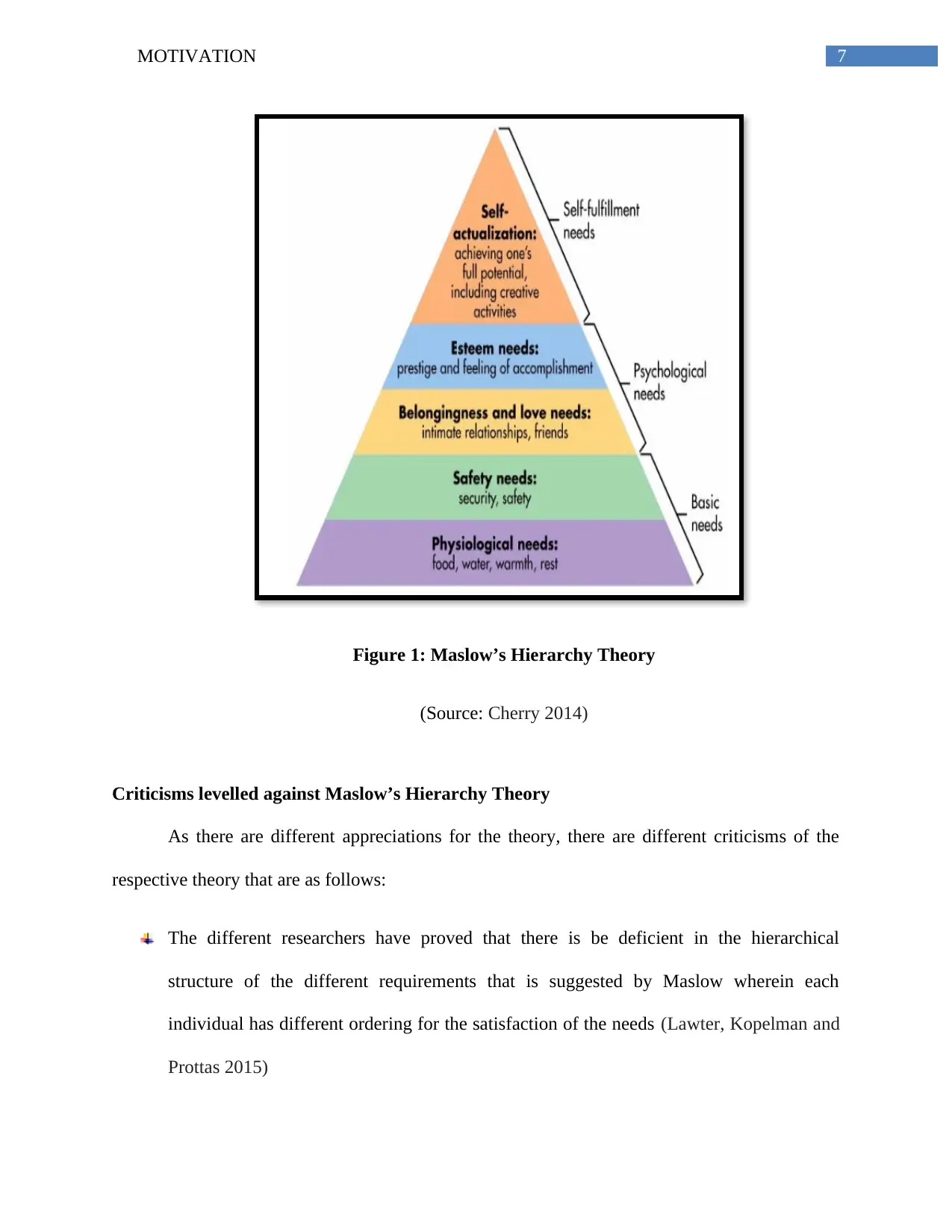
7MOTIVATION
Figure 1: Maslow’s Hierarchy Theory
(Source: Cherry 2014)
Criticisms levelled against Maslow’s Hierarchy Theory
As there are different appreciations for the theory, there are different criticisms of the
respective theory that are as follows:
The different researchers have proved that there is be deficient in the hierarchical
structure of the different requirements that is suggested by Maslow wherein each
individual has different ordering for the satisfaction of the needs (Lawter, Kopelman and
Prottas 2015)
Figure 1: Maslow’s Hierarchy Theory
(Source: Cherry 2014)
Criticisms levelled against Maslow’s Hierarchy Theory
As there are different appreciations for the theory, there are different criticisms of the
respective theory that are as follows:
The different researchers have proved that there is be deficient in the hierarchical
structure of the different requirements that is suggested by Maslow wherein each
individual has different ordering for the satisfaction of the needs (Lawter, Kopelman and
Prottas 2015)
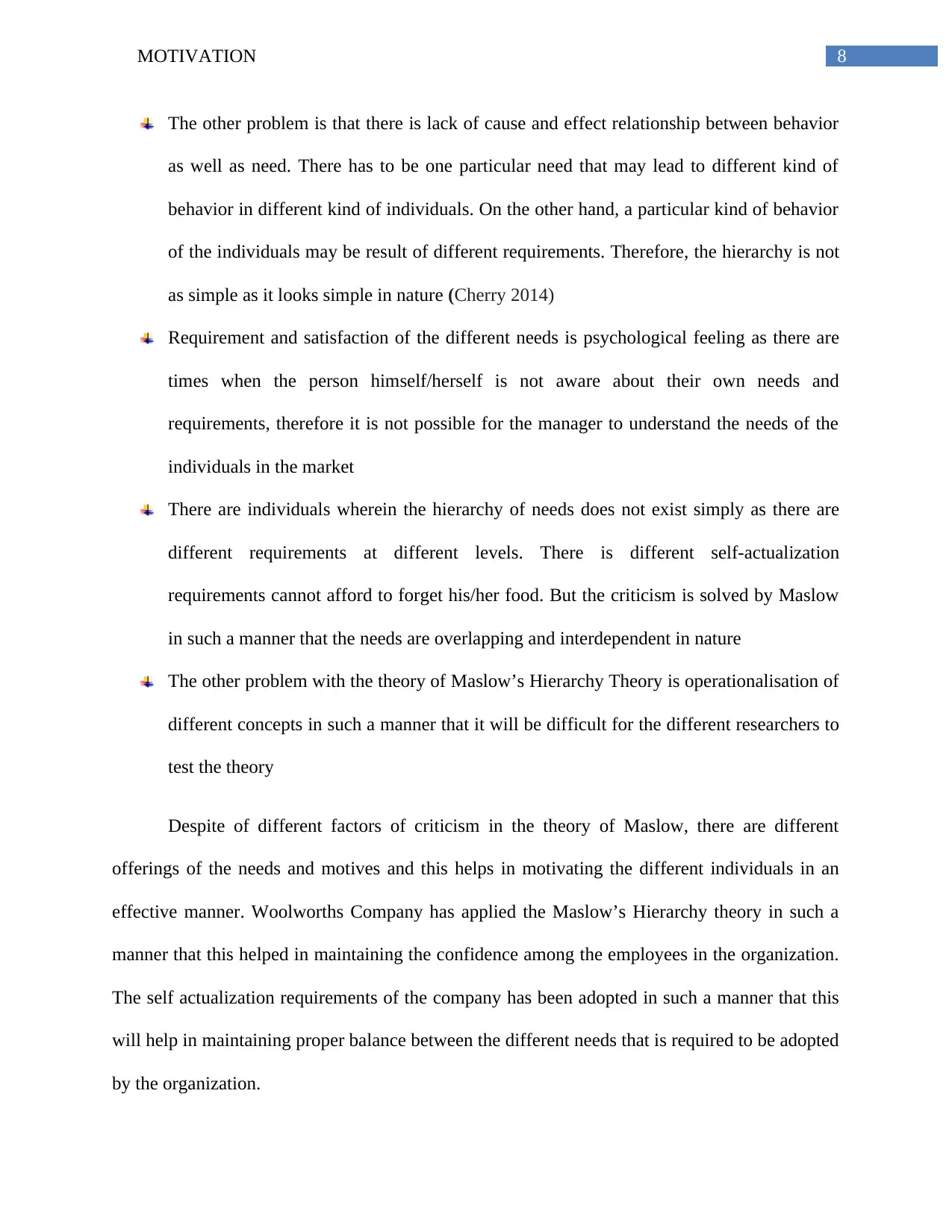
8MOTIVATION
The other problem is that there is lack of cause and effect relationship between behavior
as well as need. There has to be one particular need that may lead to different kind of
behavior in different kind of individuals. On the other hand, a particular kind of behavior
of the individuals may be result of different requirements. Therefore, the hierarchy is not
as simple as it looks simple in nature (Cherry 2014)
Requirement and satisfaction of the different needs is psychological feeling as there are
times when the person himself/herself is not aware about their own needs and
requirements, therefore it is not possible for the manager to understand the needs of the
individuals in the market
There are individuals wherein the hierarchy of needs does not exist simply as there are
different requirements at different levels. There is different self-actualization
requirements cannot afford to forget his/her food. But the criticism is solved by Maslow
in such a manner that the needs are overlapping and interdependent in nature
The other problem with the theory of Maslow’s Hierarchy Theory is operationalisation of
different concepts in such a manner that it will be difficult for the different researchers to
test the theory
Despite of different factors of criticism in the theory of Maslow, there are different
offerings of the needs and motives and this helps in motivating the different individuals in an
effective manner. Woolworths Company has applied the Maslow’s Hierarchy theory in such a
manner that this helped in maintaining the confidence among the employees in the organization.
The self actualization requirements of the company has been adopted in such a manner that this
will help in maintaining proper balance between the different needs that is required to be adopted
by the organization.
The other problem is that there is lack of cause and effect relationship between behavior
as well as need. There has to be one particular need that may lead to different kind of
behavior in different kind of individuals. On the other hand, a particular kind of behavior
of the individuals may be result of different requirements. Therefore, the hierarchy is not
as simple as it looks simple in nature (Cherry 2014)
Requirement and satisfaction of the different needs is psychological feeling as there are
times when the person himself/herself is not aware about their own needs and
requirements, therefore it is not possible for the manager to understand the needs of the
individuals in the market
There are individuals wherein the hierarchy of needs does not exist simply as there are
different requirements at different levels. There is different self-actualization
requirements cannot afford to forget his/her food. But the criticism is solved by Maslow
in such a manner that the needs are overlapping and interdependent in nature
The other problem with the theory of Maslow’s Hierarchy Theory is operationalisation of
different concepts in such a manner that it will be difficult for the different researchers to
test the theory
Despite of different factors of criticism in the theory of Maslow, there are different
offerings of the needs and motives and this helps in motivating the different individuals in an
effective manner. Woolworths Company has applied the Maslow’s Hierarchy theory in such a
manner that this helped in maintaining the confidence among the employees in the organization.
The self actualization requirements of the company has been adopted in such a manner that this
will help in maintaining proper balance between the different needs that is required to be adopted
by the organization.
⊘ This is a preview!⊘
Do you want full access?
Subscribe today to unlock all pages.

Trusted by 1+ million students worldwide
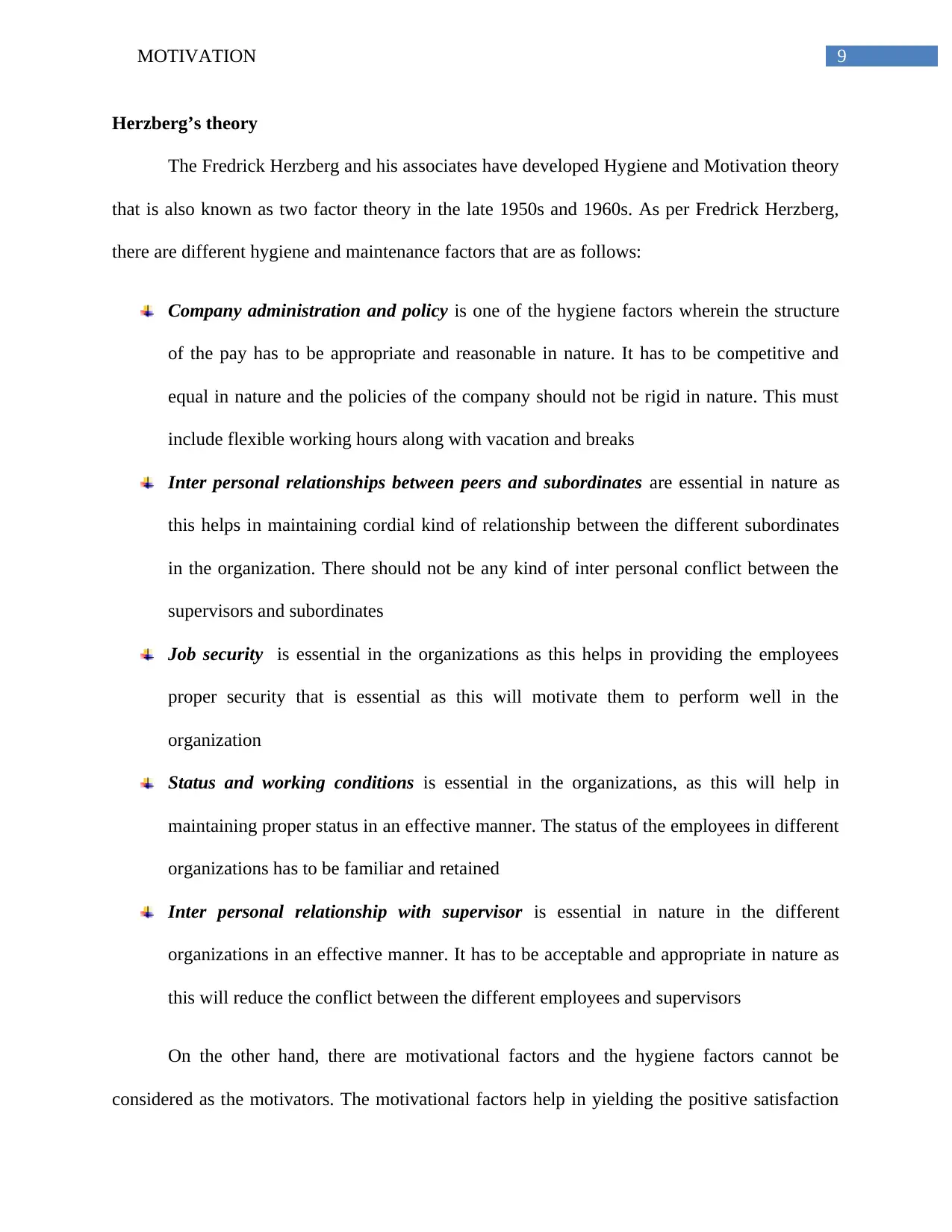
9MOTIVATION
Herzberg’s theory
The Fredrick Herzberg and his associates have developed Hygiene and Motivation theory
that is also known as two factor theory in the late 1950s and 1960s. As per Fredrick Herzberg,
there are different hygiene and maintenance factors that are as follows:
Company administration and policy is one of the hygiene factors wherein the structure
of the pay has to be appropriate and reasonable in nature. It has to be competitive and
equal in nature and the policies of the company should not be rigid in nature. This must
include flexible working hours along with vacation and breaks
Inter personal relationships between peers and subordinates are essential in nature as
this helps in maintaining cordial kind of relationship between the different subordinates
in the organization. There should not be any kind of inter personal conflict between the
supervisors and subordinates
Job security is essential in the organizations as this helps in providing the employees
proper security that is essential as this will motivate them to perform well in the
organization
Status and working conditions is essential in the organizations, as this will help in
maintaining proper status in an effective manner. The status of the employees in different
organizations has to be familiar and retained
Inter personal relationship with supervisor is essential in nature in the different
organizations in an effective manner. It has to be acceptable and appropriate in nature as
this will reduce the conflict between the different employees and supervisors
On the other hand, there are motivational factors and the hygiene factors cannot be
considered as the motivators. The motivational factors help in yielding the positive satisfaction
Herzberg’s theory
The Fredrick Herzberg and his associates have developed Hygiene and Motivation theory
that is also known as two factor theory in the late 1950s and 1960s. As per Fredrick Herzberg,
there are different hygiene and maintenance factors that are as follows:
Company administration and policy is one of the hygiene factors wherein the structure
of the pay has to be appropriate and reasonable in nature. It has to be competitive and
equal in nature and the policies of the company should not be rigid in nature. This must
include flexible working hours along with vacation and breaks
Inter personal relationships between peers and subordinates are essential in nature as
this helps in maintaining cordial kind of relationship between the different subordinates
in the organization. There should not be any kind of inter personal conflict between the
supervisors and subordinates
Job security is essential in the organizations as this helps in providing the employees
proper security that is essential as this will motivate them to perform well in the
organization
Status and working conditions is essential in the organizations, as this will help in
maintaining proper status in an effective manner. The status of the employees in different
organizations has to be familiar and retained
Inter personal relationship with supervisor is essential in nature in the different
organizations in an effective manner. It has to be acceptable and appropriate in nature as
this will reduce the conflict between the different employees and supervisors
On the other hand, there are motivational factors and the hygiene factors cannot be
considered as the motivators. The motivational factors help in yielding the positive satisfaction
Paraphrase This Document
Need a fresh take? Get an instant paraphrase of this document with our AI Paraphraser
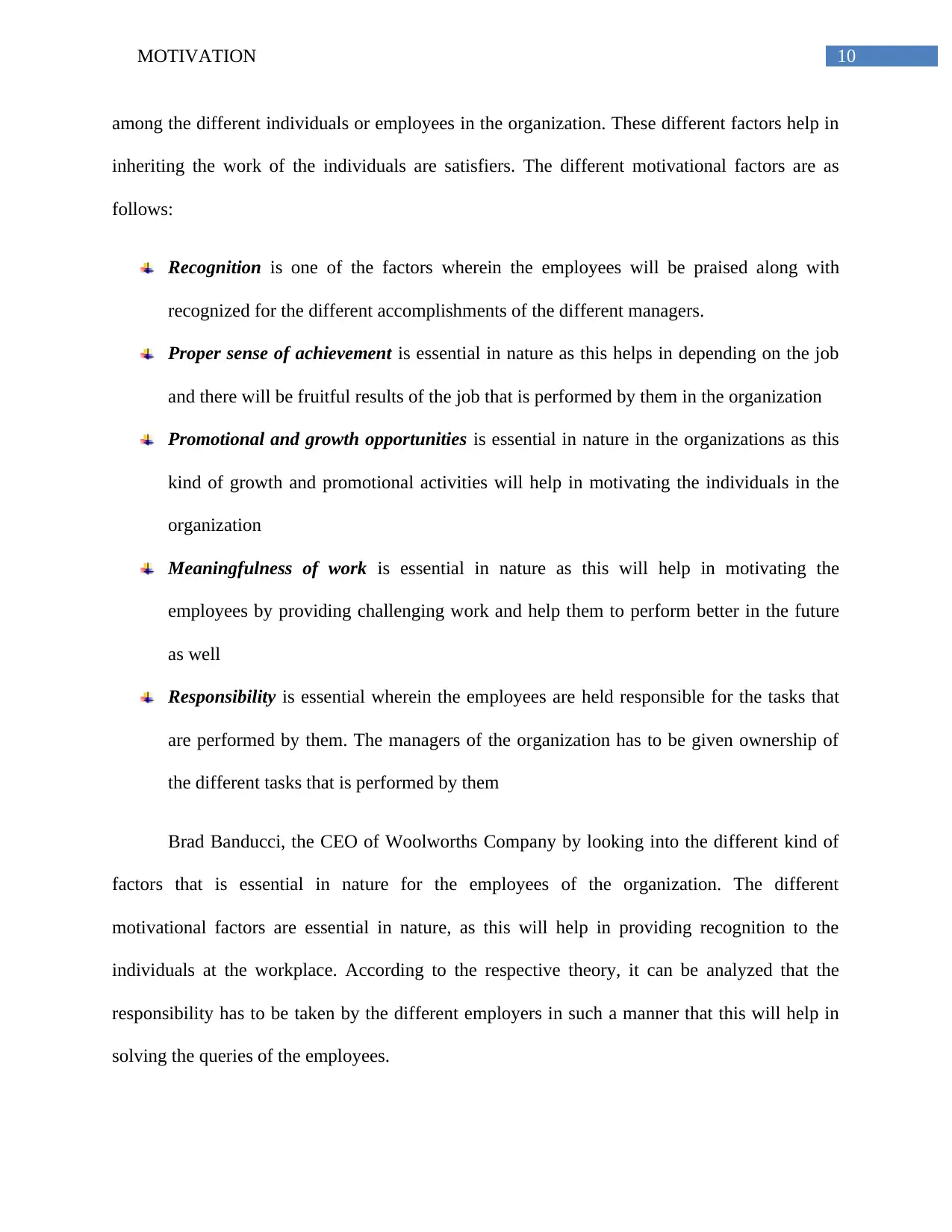
10MOTIVATION
among the different individuals or employees in the organization. These different factors help in
inheriting the work of the individuals are satisfiers. The different motivational factors are as
follows:
Recognition is one of the factors wherein the employees will be praised along with
recognized for the different accomplishments of the different managers.
Proper sense of achievement is essential in nature as this helps in depending on the job
and there will be fruitful results of the job that is performed by them in the organization
Promotional and growth opportunities is essential in nature in the organizations as this
kind of growth and promotional activities will help in motivating the individuals in the
organization
Meaningfulness of work is essential in nature as this will help in motivating the
employees by providing challenging work and help them to perform better in the future
as well
Responsibility is essential wherein the employees are held responsible for the tasks that
are performed by them. The managers of the organization has to be given ownership of
the different tasks that is performed by them
Brad Banducci, the CEO of Woolworths Company by looking into the different kind of
factors that is essential in nature for the employees of the organization. The different
motivational factors are essential in nature, as this will help in providing recognition to the
individuals at the workplace. According to the respective theory, it can be analyzed that the
responsibility has to be taken by the different employers in such a manner that this will help in
solving the queries of the employees.
among the different individuals or employees in the organization. These different factors help in
inheriting the work of the individuals are satisfiers. The different motivational factors are as
follows:
Recognition is one of the factors wherein the employees will be praised along with
recognized for the different accomplishments of the different managers.
Proper sense of achievement is essential in nature as this helps in depending on the job
and there will be fruitful results of the job that is performed by them in the organization
Promotional and growth opportunities is essential in nature in the organizations as this
kind of growth and promotional activities will help in motivating the individuals in the
organization
Meaningfulness of work is essential in nature as this will help in motivating the
employees by providing challenging work and help them to perform better in the future
as well
Responsibility is essential wherein the employees are held responsible for the tasks that
are performed by them. The managers of the organization has to be given ownership of
the different tasks that is performed by them
Brad Banducci, the CEO of Woolworths Company by looking into the different kind of
factors that is essential in nature for the employees of the organization. The different
motivational factors are essential in nature, as this will help in providing recognition to the
individuals at the workplace. According to the respective theory, it can be analyzed that the
responsibility has to be taken by the different employers in such a manner that this will help in
solving the queries of the employees.
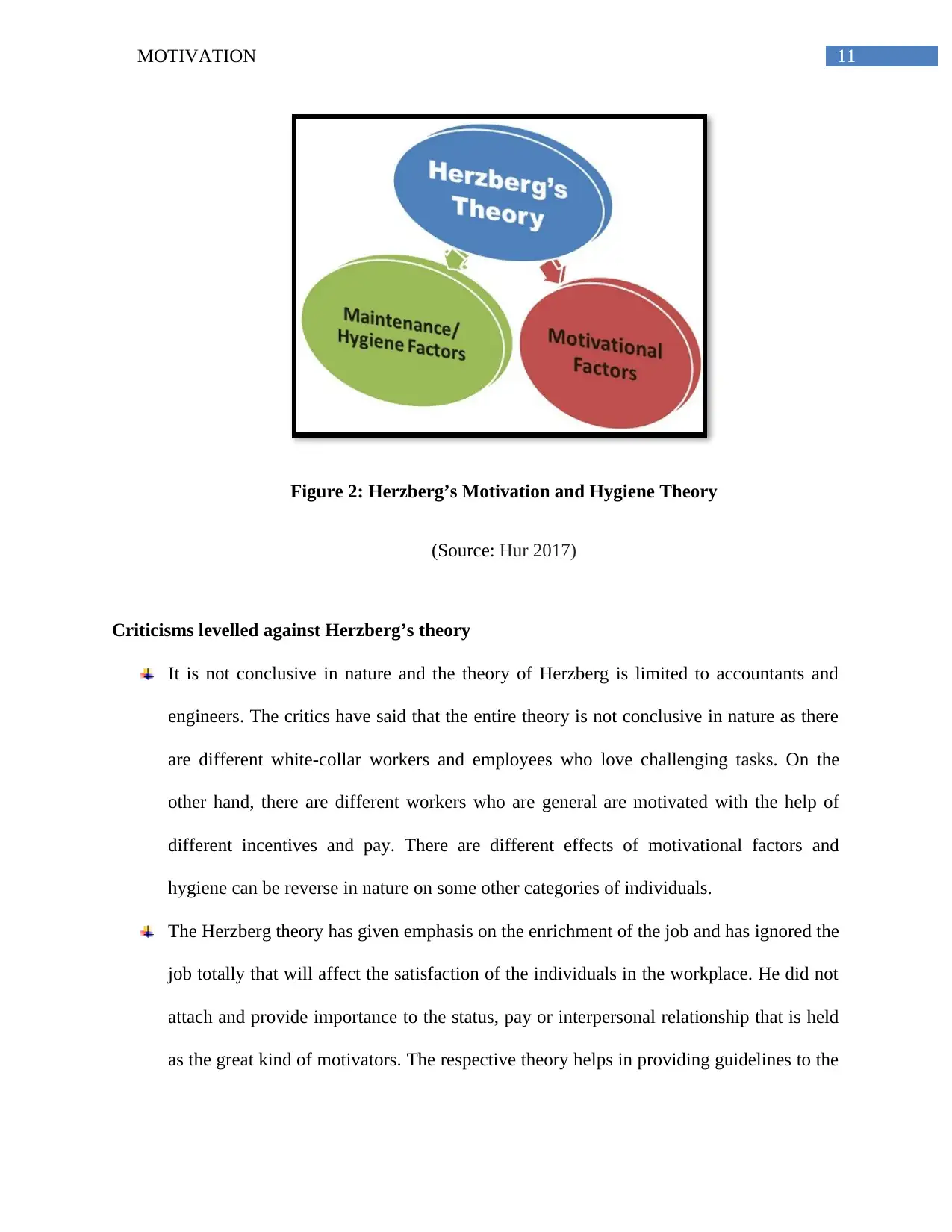
11MOTIVATION
Figure 2: Herzberg’s Motivation and Hygiene Theory
(Source: Hur 2017)
Criticisms levelled against Herzberg’s theory
It is not conclusive in nature and the theory of Herzberg is limited to accountants and
engineers. The critics have said that the entire theory is not conclusive in nature as there
are different white-collar workers and employees who love challenging tasks. On the
other hand, there are different workers who are general are motivated with the help of
different incentives and pay. There are different effects of motivational factors and
hygiene can be reverse in nature on some other categories of individuals.
The Herzberg theory has given emphasis on the enrichment of the job and has ignored the
job totally that will affect the satisfaction of the individuals in the workplace. He did not
attach and provide importance to the status, pay or interpersonal relationship that is held
as the great kind of motivators. The respective theory helps in providing guidelines to the
Figure 2: Herzberg’s Motivation and Hygiene Theory
(Source: Hur 2017)
Criticisms levelled against Herzberg’s theory
It is not conclusive in nature and the theory of Herzberg is limited to accountants and
engineers. The critics have said that the entire theory is not conclusive in nature as there
are different white-collar workers and employees who love challenging tasks. On the
other hand, there are different workers who are general are motivated with the help of
different incentives and pay. There are different effects of motivational factors and
hygiene can be reverse in nature on some other categories of individuals.
The Herzberg theory has given emphasis on the enrichment of the job and has ignored the
job totally that will affect the satisfaction of the individuals in the workplace. He did not
attach and provide importance to the status, pay or interpersonal relationship that is held
as the great kind of motivators. The respective theory helps in providing guidelines to the
⊘ This is a preview!⊘
Do you want full access?
Subscribe today to unlock all pages.

Trusted by 1+ million students worldwide
1 out of 22
Related Documents
Your All-in-One AI-Powered Toolkit for Academic Success.
+13062052269
info@desklib.com
Available 24*7 on WhatsApp / Email
![[object Object]](/_next/static/media/star-bottom.7253800d.svg)
Unlock your academic potential
Copyright © 2020–2025 A2Z Services. All Rights Reserved. Developed and managed by ZUCOL.





